Ifb Appliances Senator Aqua SX 8KG 1400RPM User Manual
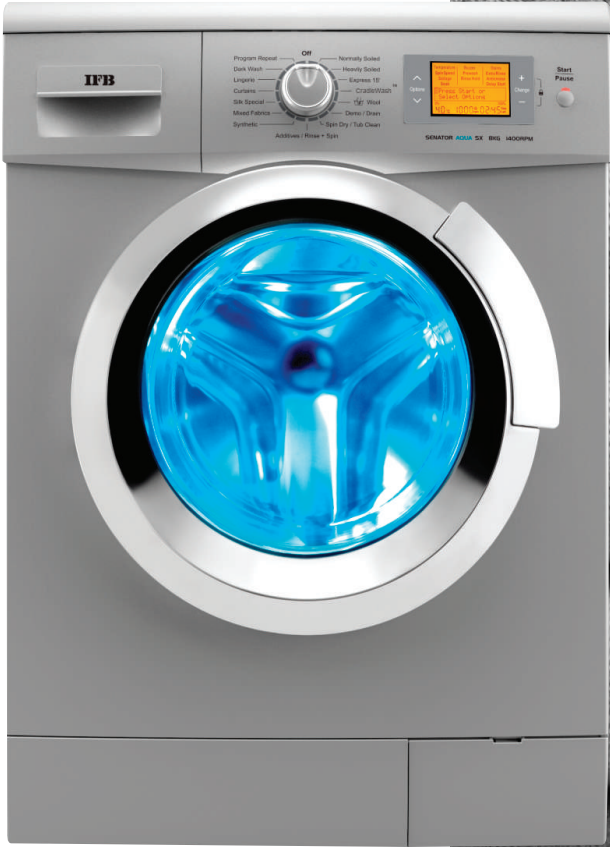
Content
Introduction
The IFB Appliances Senator Aqua SX 8KG Machine 1400RPM is a fully automatic front-load washing machine designed for efficiency and convenience in modern households. With a capacity of 8 kg, it is ideal for families of 4 to 5 members, offering 15 wash programs to handle various fabric types and soil levels. The powerful 1400 RPM spin speed ensures effective drying, while features like Aqua Energie technology enhance washing performance. Priced at approximately $400, it combines advanced technology with user-friendly features for a superior laundry experience.
Product Overview
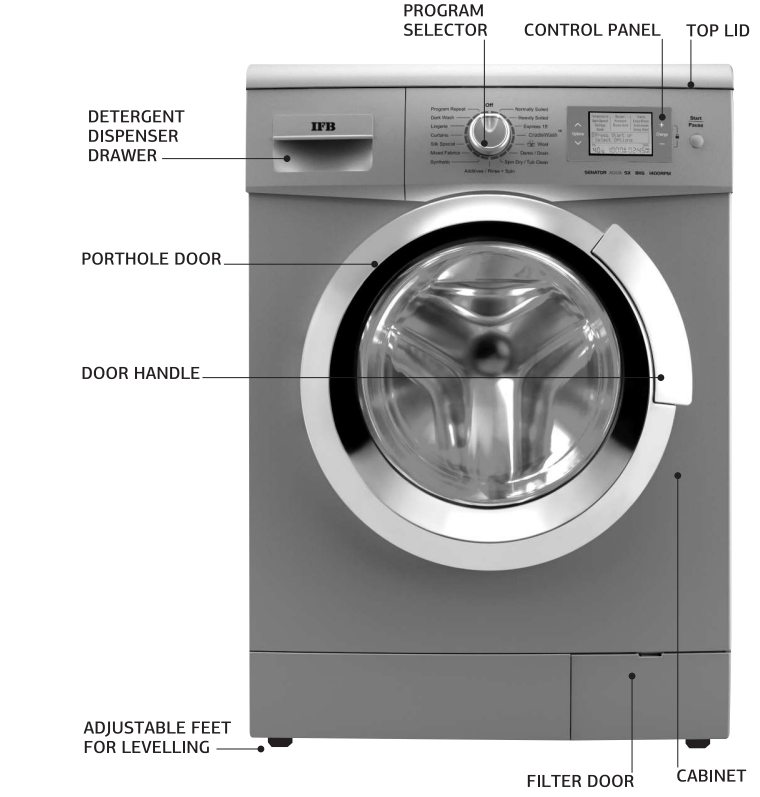
Control Panel
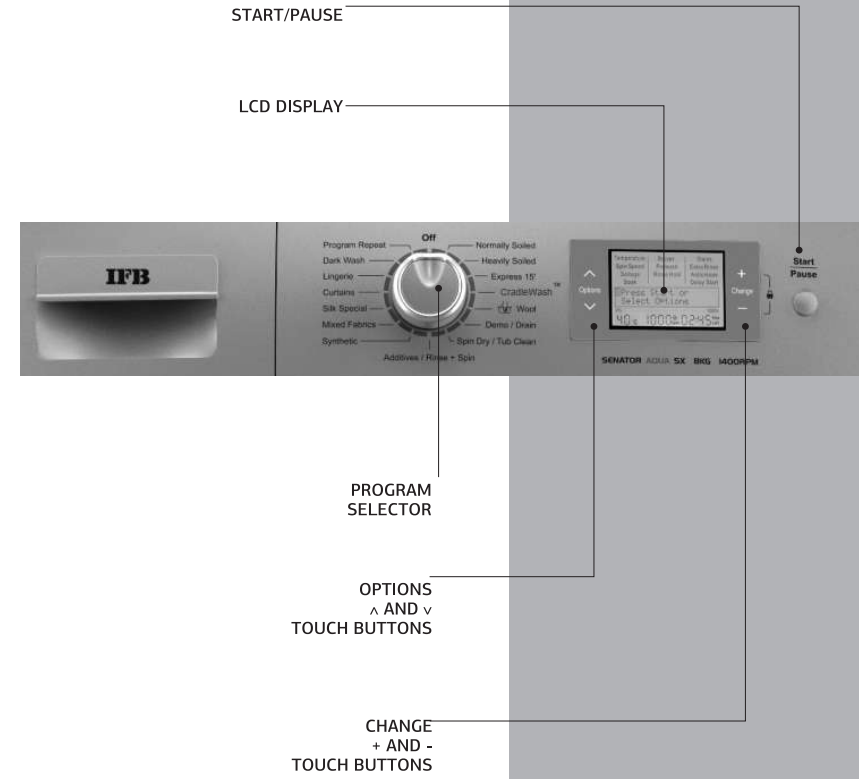
Specifications
- Model: Senator Aqua SX 8KG 1400RPM
- Power supply: 220-240 V Single Phase 50 Hz
- Dimension: 60.6cm (D) x 59.8cm (W) x 87.5cm (H)
- Net weight: 75 Kg
- Capacity: 8 Kg of dry cotton
- Wash care programs: 15 (>100 with options)
- Selector buttons: Start/Pause, Options ^ and v, Change + and -
- Selector knob: Program selector
- Spin speed: 400-1400 RPM or spin cancel
- Program duration: 147 minutes maximum 15 minutes minimum
- Water consumption*: 60 Litres
- Water pressure: 0.3 Bar-10 Bar (0.03 MPa-1.0 MPa)
- Power consumption max: 2250 W
- Drain pump rating: 30 W
- Heater rating: 2000 W
- Drum: Stainless steel
Description
The IFB Appliances Senator Aqua SX 8KG 1400RPM washing machine boasts a sleek and durable design, making it a stylish addition to any modern kitchen. The stainless steel drum ensures longevity and prevents rust, while the electronic controls with an LED display provide easy operation and clear cycle indicators. This model features multiple wash cycles, including a specific cycle for delicate fabrics, ensuring that your clothes are cleaned thoroughly without damage. The high spin speed of 1400 RPM reduces drying time significantly, making it a time-saving option for busy households.
Getting Started With Your Machine
Installing your machine & safety guidelines
Select the right spot
Unpack and place the new washing machine in proximity to both water and electrical connections. Ensure that the floor is properly levelled.

Removing the transit bolts
- Use a spanner to remove the transit bolts.
- Insert plastic caps provided.
- Keep the transit bolts carefully as they will be required in case you need to shift the machine again.
- Please do not operate the machine until the transit bolts have been removed.
Leveling

- Level the machine by using the adjustable screws provided at the bottom for levelling.
Make sure that the machine rests on all four feet on a level surface.

Connection to the water supply
The water inlet of the machine has a collar with parallel internal threads.

- The water supply point with an external thread/parallel thread should be available within 1 metre of the machine location.
Do not stretch the water supply hose.
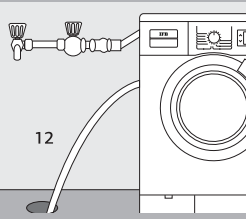
Connection to the drain hose

- The machine drains via a drain pump.
- Direct the end of drain hose into a sink or a basin.
The drain hose should not be placed higher than 1 00 cm and not lower than 60 cm above the floor.
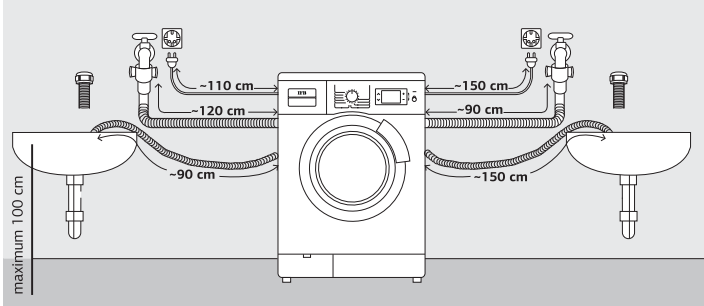
Electrical connection
- It is mandatory to have a 16 Amp, 3 pin 220-240 V AC, 50 Hz electrical point with a 16 Amp MCB or automatic short circuit protection device within 1 metre of the machine.
- Make sure your home has proper earthing and there is a firm connection between the plug and the socket. IFB recommends a separate MCB on the socket of the washing machine.
- Proper earthing of the power socket is critical to reliable performance.
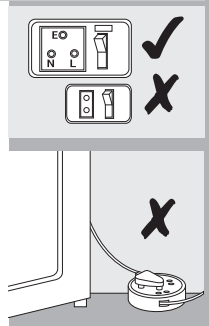
Get More From Machine
Tips for best results
Before washing
- Empty all pockets.
- Remove metals parts.
- Close any zips and fasten hooks etc before washing.
- Do not wash anything in the machine that is specified as non-machine washable on the wash care label.
While sorting
- Separate polyester fabrics from cotton fabrics.
- Try to have a mix of large and small clothes in each wash load.
- Dark clothes should be washed separately and not with whites.
While loading
- Load large items first, preferably half the total wash load.
- Do not wash single items-add one or two similar items.
- Place small items such as infants' socks, nylon stockings, handkerchiefs etc in a laundry bag, pillow case or something similar, as they may get caught around the door. This will also save your laundry from getting lost.
Water softening
- Use water softening agents or adjust detergent dosage as recommended by the detergent manufacturer in case of hard water.
Easy tips to remove stains
- Ensure you use warm water for soaking or pre washing stained laundry.
- Fresh stains are easier to remove.
- Knowing what kind of stain it is, how old it is, what kind of fabric it is, and whether the fabric is color fast (check the care label) always helps treat a stain better.
- Always start with cold or warm water as hot water can set in stains. Washing and drying can sometimes set in stains.
- When bleach is recommended, always use a fabric-safe one. Put the stained area face down on a paper towel or white cloth. Apply the stain remover to the back of the stain. This forces the stain off the fabric instead of through it.
| Stain | Treatment |
|---|---|
| Chewing Gum, Adhesive Tape, Rubber, Cement | Use ice in a plastic bag to harden the gum. Scrape off what you can and then sponge with white spirits. |
| Blood | Rinse immediately in COLD water. If stain remains, soak in COLD water with an enzyme pre-wash. |
| Chocolate, Cocoa | Sponge with COLD water and soak in an enzyme pre-wash. If stain persists, rub a little detergent and rinse in COLD water. |
| Coffee | Blot up quickly and rinse out in COLD water. Rub in a little detergent and wash in the maximum temperature allowed for the fabric type. |
| Cream, Milk, Ice Cream | Rinse in COLD water and wash normally. If stain is still apparent, sponge with white spirits. |
| Deodorant | Rub affected areas with white vinegar and then rinse out in COLD water. Sponge with white spirits. Treat stiffened areas with an enzyme pre-wash. |
| Fabric Softener | Soak in a COLD enzyme pre-wash, rinse and wash normally. |
| Fruit | Treat as soon as possible by sponging with COLD water. Rub affected areas with bar soap and wash normally. |
| Grass | Sponge with white spirits, rub in an enzyme pre-wash and wash normally. |
| Grease, Oil | Lay the affected area face down on an absorbent cloth and work from the back. Sponge with white spirits or dry cleaning fluid. Wash normally. |
| Iron, Rust | Apply lemon juice and salt and place in the sun or dry cleaning fluid. Wash normally. |
| Collars, Cuffs, Cosmetics | Pre-treat with pre-wash stain remover or rub with bar soap. Wash in WARM water and detergent. Moisten area with lemon juice, dry in the sun and wash normally. If stain persists and fabric allows, use a bleach. |
| Mud | Brush off dry mud and rinse in COLD water. If stain persists, rub in a little detergent and wash normally. |
| Paint - Oil-Based | Scrape off any fresh paint and sponge with a non-flammable dry cleaning fluid and wash normally. |
| Paint - Water-Based | Treat while still wet. Rinse in WARM water and wash normally. |
| Scorch Marks | Dampen a cloth with hydrogen peroxide, lay it over the affected area and press with a fairly HOT iron. |
| Ink | Some inks may be impossible to remove and washing may even set it in. Use pre-wash stain remover, denatured alcohol or non-flammable dry cleaning fluid. |
| Nail Polish | May be impossible to remove in some cases. Place stain face down on paper towels. Apply nail polish remover to the back of the stain. Repeat, placing paper towels frequently. Do not use acetate fabrics. |
| Shoe Polish (Liquid) | Pre-treat with a paste of granular detergent and water. |
| Shoe Polish (Paste) | Scrape residue from fabric. Pre-treat with pre-wash stain remover or non-flammable dry cleaning fluid. Apply detergent into dampened area and wash using fabric-safe bleach. |
| Candle Wax, Crayon | Scrape off surface wax. Place stain face down between paper towels. Press with a WARM iron until wax is absorbed. Replace paper towels frequently. Treat remaining stain with pre-wash stain remover or non-flammable dry cleaning fluid. Hand wash to remove solvent and wash using fabric-safe bleach. |
Setup Guide
To operate the IFB Appliances Senator Aqua SX 8KG 1400RPM, follow these steps:
- Unpack the washing machine and remove all packaging materials.
- Place the washing machine on a level surface to ensure proper balance.
- Connect the water inlet hose to a water source and ensure secure connection.
- Plug in the power cord and turn on the washing machine.
- Select the desired wash cycle using the electronic controls.
- Add detergent according to the load size and fabric type.
- Close the lid and start the cycle.
Maintenance and cleaning of your washing machine
Cleaning the detergent dispenser drawer
- Remove detergent residues regularly.
- Pull out the detergent dispenser drawer.
- Clean the detergent dispenser drawer with WARM water.
- Clean the siphon. Remove the siphon from the compartment and wash it under running WARM water.
- Detergent residues can build up in the water jets on top of the detergent dispenser drawer housing.
Before fixing the detergent dispenser drawer use a bottle brush to clean them out.
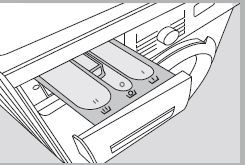
Cleaning the water hose mesh filter
Turn OFF taps. Disconnect power supply to the machine. Unscrew the inlet hose from machine and the tap.
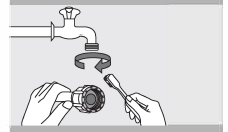
- Drain water from the hose.
- Remove the filter mesh from the tap end of the inlet hose and clean under running water with a brush.
- Pull the sieve out of the magnetic valve with a pair of flat nosed pliers. Clean the sieve under running water with a brush. Then fit the sieve back into the valve.
Screw inlet hose back to the machine and the tap. Ensure that the sieve and filter are in place. Turn ON water tap to check if the connection is watertight.

Cleaning the filter
- Filter should be cleaned frequently in order to increase the life of the drain pump.
- Open the detachable bottom door by using a coin or key.
- Place a shallow container near the bottom door. Pull out the drain hose and open the drain plug to drain out the water from the machine in the container.
- After draining the water through the drain plug, open the filter by rotating it anti-clockwise and remove foreign objects like coins, pins or hooks, if any.
- Tighten the filter and drain plug to their original positions and close the bottom door.
Do not open the filter during a program run.

Use of descalant
- Use descalant periodically to increase the life of the heater and to remove scaling on the heater and drum due to hard water.
- Follow the instructions of the descalant manufacturer and make sure that there is no laundry in the washing machine while using it.
Only use proprietary non-corrosive descaling agents.

Tub Clean Program
Run this program to eliminate any impurities, scaling, bacteria and unpleasant smell from the washing machine.
Before running the Tub Clean program, empty the washing machine drum; there shouldn't be any clothes in the washing machine during Tub Clean program. Adding a small amount of Powder detergent or descalant (refer topic Use of descalant) will additionally improve the effect of the Tub Clean program.

To run the Tub Clean Program
IMPORTANT Do not put laundry in the washing machine during Tub Clean.
- Switch ON the washing machine.
- Put powder detergent or descalant in 'II' detergent dispenser drawer.
- With no laundry in drum, rotate program selector to 'Spin Dry/Tub Clean' position.
- Display will indicate 'Spin Dry: Press +', Tub Clean: Press -'
- Press ' - ' button to select Tub Clean program.
- Press Start/Pause button to Start Tub Clean program.
'End' will be displayed when program finishes.
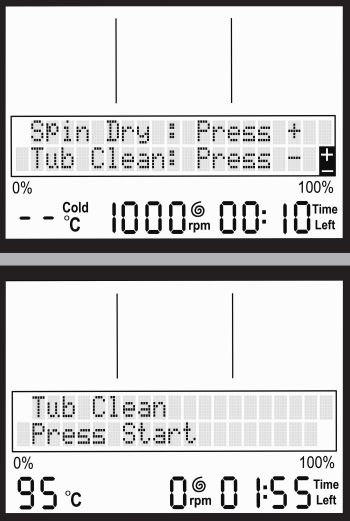
If you do not regularly use washing programs with temperatures over 60 ° C, it is recommended to run the Tub Clean program at least once per month.
Use of descalant
- Use descalant periodically to increase the life of heater and to remove scaling on heater and drum due to hard water.
- Follow the instruction of descalant manufacturer and make sure that there is no laundry in the washing machine while using it.
- Only use proprietary non-corrosive descaling agents.
Cloth weight
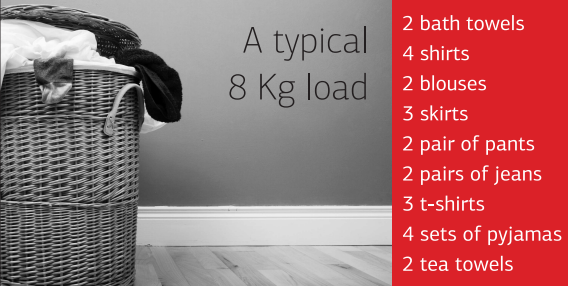
Sheets
- Cotton (double): 1 Kg
- Cotton (single): 500 g
- Non-cotton (double): 650 g
- Non-cotton (single): 400 g
Pillow Slips
- Cotton pillow slips: 110 g
- Other pillow slips: 85 g
Table Cloth
- Small: 230 g
- Large: 600 g
- Table napkins (4): 150 g
Bedspread
- Bedspread: 3 Kg
Blankets
- Wool: 2 Kg
- Acrylic: 1.5 Kg
Bottoms
- Lungi/Dhoti
- Skirts
- Trousers
- Jeans
Tops
- Cotton shirts
- Other shirts
- Cotton blouses
- Other blouses
- Woollen sweaters
- Heavy sweaters
- Light sweaters
- Other clothes
Sarees
- Cotton saree: 400 g
- Synthetic saree: 300 g
Towels
- Bath towels: 600 g
- Hand towels: 250 g
Other Clothing
- Pyjama kurta: 400 g
- Panties: 60 g
- Cotton vests: 100 g
- Underslips: 100 g
- Long socks, 2 pairs: 150 g
- Short socks, 2 pairs: 85 g
- 6 handkerchiefs: 85 g
- 12 napkins: 1.1 Kg
Safety guidelines for installation
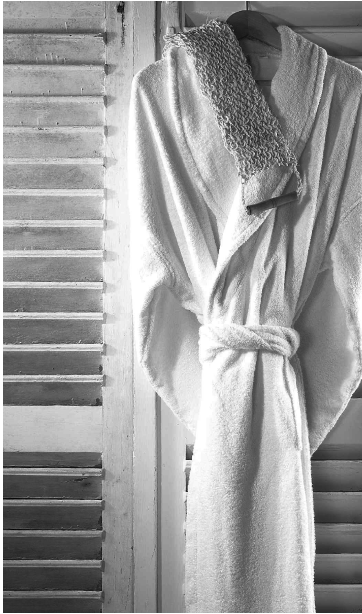
- Keep the packaging material. It may come in handy when shifting residence.
- Old hoses must not be reused. Always use the new hoses delivered with the machine. Before cleaning the machine, ensure that you disconnect the main electricity supply and take the plug out of the socket.
- Not removing all the packaging and transit bolts before using the appliance may lead to serious damage. Please do not operate the machine until the transit bolts have been removed.
- All washing machine installation work must be carried out only by authorised IFB Service Personnel.
- Pre-installation work such as plumbing and electrical connections must be carried out by a qualified fitter, electrician or technician.
- Do not operate the appliance where inflammable substances such as oil, benzene or highly inflammable gas are present. Such materials may cause fire or explosion. Never use combustible detergents.
- Do not install your washing machine in rooms where temperatures below freezing may occur. Frozen hoses may burst under pressure. The reliability of the electronic control unit may be impaired at temperatures below freezing point O and above SO C.
- Install the machine in a room with adequate ventilation. Avoid a room with no windows. The back of the machine should be at least 4 inches (1 00 mm) away from the wall.
- The machine is provided with ventilating openings on the base. Always put the machine on the floor after removing the carpet.
- Do not install the machine in a damp area or bathroom with exposure to a direct shower.
- Protect the machine from direct sunlight and rainfall.
- Do not place the machine on a slanting, uneven or unstable surface.
- A concrete floor is the most suitable installation surface for a washing machine, being far less prone to vibration during the spin cycle than wooden floorboards.
The washing machine is not suitable for connection to a hot water supply.
The machine is designed to operate with water flow pressure between 0.3 Bar-10 Bar. Lower water pressure can lead to machine malfunction.
Read all instructions and explanations for installation carefully before use. Follow the instructions carefully. Keep the operating instructions handy for later use.
Safety Information
Any damage, which may be caused by cockroaches or other vermin, will not be covered by the appliance guarantee.
- Do not install and use a damaged machine. Before connecting the machine, ensure that the connection data on the data plate (fusing, voltage and frequency) match the main electricity supply. If in any doubt, consult IFB Care.
- Do not wash or dry articles that have been cleaned, washed, soaked in or dabbed with combustible or explosive substances (such as oil, paint, gasoline, degreasers, dry cleaning solvents, kerosene etc). This may result in fire or explosions.
- Before using the machine for the first time, check that the transit bolt at the rear of the machine has been removed (refer topic Safety Guidelines for installation).
- Turn OFF the stopcock if the machine is to be left for any length of time (eg holidays) especially if there is no floor drain (gully) in the immediate vicinity.
- This appliance can be used by children aged 8 years and above and persons with reduced physical, sensory or mental capabilities or lack of experience and knowledge if they have been given supervision or instructions concerning the use of the appliance in a safe way and understand the hazards involved.
- Children should not play with the appliance.
- Cleaning and user maintenance should not be performed by children without supervision.
Caution
- The electrical safety of this appliance can only be guaranteed when continuity is complete between the machine and an effective earthing system, which complies with local and national regulations. It is most important that a qualified electrician regularly tests this basic safety requirement. The manufacturer cannot be held responsible for the consequences of an inadequate earthing system.
- For safety reasons do not operate this appliance on an extension cable. Extension leads do not guarantee the required safety of the appliance. There is danger of overheating.
The machine is built in accordance with current safety requirements.
Unauthorised repairs could result in unforeseen dangers for the user, for which the manufacturer cannot accept responsibility. Only authorised IFB personnel should undertake repairs. - The machine is only completely isolated from the electricity supply when it is switched OFF at the wall socket and the plug is taken out, or it is switched OFF from the main source, or the main fuse is taken out or the MCB switched OFF. This machine must only be connected to the onsite water supply using a new hose kit. Old hoses must not be reused. Only genuine IFB original spare parts must replace faulty components. Only when these parts are fitted can the safety standards of the machine be guaranteed.
If the connection cable is faulty it must be replaced only by an IFB approved service technician to protect the user from danger. - A washer and dryer should never be stacked without using the proper stacking kit. Doing so is extremely dangerous, as the dryer may vibrate off the washing machine during use.
Warnings
- Do not pull the cord to disconnect the plug. Hold the plug itself. Do not insert or remove the plug with damp hands.
- Do not drag or move the washing machine if it contains the wash load or when in operation.
- Do not spill water over the machine. In case of spillage, wipe dry. Avoid the machine coming in contact with floor cleaning chemicals.
- Do not wash or spray water over the switch or control panel.
- Do not wash shoes or utensils in the machine.
- Use detergent recommended for washing machines.
- Keep your machine dry to avoid corrosion/rusting. Take special care to wipe the machine after cleaning coin trap.
- Check label on garments for determining conditions under which fabrics are to be washed.
- The machine is tested with water during assembly for performance checking. Condensed droplets of water may remain inside the drum. It is advisable to run the machine without a wash load in Cotton maximum temperature program with detergent for the first time after installation. Ensure that the machine is connected to a 3 pin socket with good earthing and 1 6 Amp MCB or other automatic short circuit protection devices.
- Textiles that have been pre-treated in solvent-based cleaning agents must be thoroughly rinsed in clean water before being washed in the machine.
- Never use solvent-based cleaning agents in this machine, as this may result in damage to component parts and create toxic fumes. Such detergents also pose a threat of fire and explosion hazards.
- Only use dyes specified by the manufacturer as suitable for use in a domestic washing machine. Always read the manufacturer's instructions carefully.
- Colour run and dye removers contain sulphur compounds, which can cause damage such as corrosion. Do not use such products in this machine.
- For machines with a porthole door, remember that the porthole glass will be hot when washing at very high temperatures. Do not let children touch it.
- Always make sure that the drum is stationary before removing clothes. Reaching into a moving drum is extremely dangerous.
Flooding danger
- While hooking the drain hose into a wash basin, check that the water drains OFF quickly to prevent the sink from overflowing. Make sure the drain hose is secure so that the force of the water flowing out of the hose does not dislodge it. Otherwise this will result in flooding.
- Take care to ensure that foreign objects (eg nails, pins, coins, paper clips etc) do not find their way into the machine with the washing. These may damage components of the machine (eg suds container, drum etc), which in turn can result in damage to the washing.
Troubleshooting
SYMPTOM: LCD Display does not glow.
| Probable Cause | Solution |
|---|---|
| Power supply is not turned ON | Ensure that the supply mains switch is ON. |
| Electrical power cord may not be plugged in or connection may be loose | Make sure that the plug is plugged in and check for loose connection in plug/socket. |
| Program Selector in OFF position | Ensure that the program is selected. |
SYMPTOM: Washing machine door does not open.
| Probable Cause | Solution |
|---|---|
| Machine is in operation | Check if the program is active. If yes, pause the program and check if 'Door Unlocking Pls Wait' or 'Door open possible' message is shown. For safety reasons, the washing machine door cannot be opened when water level, temperature or speed is too high. |
| Door open not possible. | Check if 'Door Unlocking' or 'Door Open not possible' message is displayed. |
| Child Lock is active. | Disable the Child Lock and wait for 1-2 minutes till 'Door open possible' or 'Remove Washed Clothes', 'Switch OFF appliance' is displayed. |
SYMPTOM: Program does not start.
| Probable Cause | Solution |
|---|---|
| Machine Start/Pause button not pressed | Ensure that the Start/Pause button is pressed. Start/Pause LED will glow when pressed. |
| Water supply tap not turned ON/ no water supply/low water pressure | Open tap fully and ensure that there is water supply with normal water pressure. |
| Door not closed properly | Open and close the door firmly. |
| Program either in Pause/Soak or Rinse Hold mode | Check the status on the display and refer to the user manual. |
SYMPTOM: Water does not enter into machine. Detergent not being flushed into the drum.
| Probable Cause | Solution |
|---|---|
| Water supply tap not turned ON/ no water supply/low water pressure | Open the tap fully and ensure that there is water supply with normal water pressure. |
| Door not closed properly | Open and close the door firmly. |
| Bent inlet hose, sieve or inlet valve/inlet hose clogged | Check if the inlet hose is bent or sieve is blocked. |
SYMPTOM: Suds escaping from detergent dispenser tray. Excessive foam in drum. Residues of detergent on clothes.
| Probable Cause | Solution |
|---|---|
| Detergent used is not a Front Loading detergent | Use detergent recommended for Front Loading washing machines only. |
| Excessive detergent used | Reduce the detergent dosage. |
| Overloading of clothes | Do not overload the wash. |
| Cold wash program | Use hot wash program. |
| Low water pressure | Start when water pressure is normal. |
SYMPTOM: Water leakage from machine.
| Probable Cause | Solution |
|---|---|
| Inlet hose connection loose | Check and tighten the inlet hose connection. |
| Filter not tightened | Check and tighten the filter. |
| Inlet hose leaking | Contact IFB Care. |
SYMPTOM: Machine does not drain.
| Probable Cause | Solution |
|---|---|
| Filter clogged | Check and clean the filter. |
| Drain hose kinked or clogged | Clean and straighten the drain hose. |
| Drain hose end above 1 metre from the floor level | Drain hose should be placed between 1 metre to ground level. |
SYMPTOM: Machine does not spin or clothes stay wet.
| Probable Cause | Solution |
|---|---|
| Load is too small, Unbalanced load | Add 1 or 2 similar items to help balance the load. Rearrange load to allow proper spinning. |
| Overloading of clothes | Load clothes as per the fabric type and capacity recommended for the chosen program. |
| Spin Speed is set to 0 RPM or lower Spin Speed is selected | Select higher Spin Speed. |
| Rinse Hold option selected | At Rinse Hold stage press "Start/Pause" button. |
| Filter clogged | Check and clean filter. |
| Excessive/high foaming detergent | Use detergent recommended for Front Loading washing machines only. |
SYMPTOM: Machine vibrates more during spinning.
| Probable Cause | Solution |
|---|---|
| Machine not leveled properly | Check and level the machine. |
| Filter clogged partially | Check and clean the filter. |
| Unbalanced load | Add 1 or 2 similar items to help balance the load. Rearrange load to allow proper spinning. |
SYMPTOM: Motor noise.
- It is normal for noises to be heard while the motor is running.
SYMPTOM: Pump noise.
- It is normal for noises to be heard from the pump during the start-up and final stage of draining. However, check for filter clogging.
SYMPTOM: Program cycle time delayed.
- It is normal as the washing machine time may vary depending upon the type and quantity of laundry, inlet water pressure, inlet water temperature, variations in power supply and other usage conditions.
- If the load is unbalanced, the machine may make several attempts to redistribute the clothes in order to minimize the vibrations resulting in extended program duration.
SYMPTOM: Poor soil removal.
| Probable Cause | Solution |
|---|---|
| Incorrect detergent dosage | Use correct amount of detergent for load size and water hardness. |
| Use of cold wash program | Use hot wash program. |
| Load size not as per capacity | Use correct load size. |
| Stains on clothes | Pre-treat stain and any soil according to directions given under 'Easy tips to remove stains'. |
| Mix of heavily soiled items with lightly soiled items | Separate heavily soiled items from lightly soiled ones. |
SYMPTOM: Blue stains on clothes.
| Probable Cause | Solution |
|---|---|
| Excessive fabric additives | Do not overfill fabric softener and do not pour liquid fabric softener directly onto fabric. |
| Cheaper quality additives | Use good quality detergents and fabric softeners. |
SYMPTOM: Black or grey marks on clothes.
| Probable Cause | Solution |
|---|---|
| Less quantity detergent/hard water | Use correct amount of detergent for load size, amount of soil and water hardness. |
| Some clothes already with existing stains | Do not mix good clothes with stained clothes. |
SYMPTOM: Yellow or brown rust stains.
| Probable Cause | Solution |
|---|---|
| Dirty incoming water | Before washing run water for a few minutes to clean lines or start the program only when the water is clean. |
| Dirty washing machine | To restore discolored load of whites use rust remover safe for fabric. |
SYMPTOM: Residue of detergent.
| Probable Cause | Solution |
|---|---|
| Overloading of clothes | Do not overload the washer. |
| Excessive use of detergent | Use correct amount of detergent. |
| Cold wash program | Use hot wash program. |
SYMPTOM: Buttons not working.
| Probable Cause | Solution |
|---|---|
| Button not pressed/touched properly | All the buttons are sensitive and need to be gently tapped/touched with finger. |
Display
The LCD Display gives you complete information
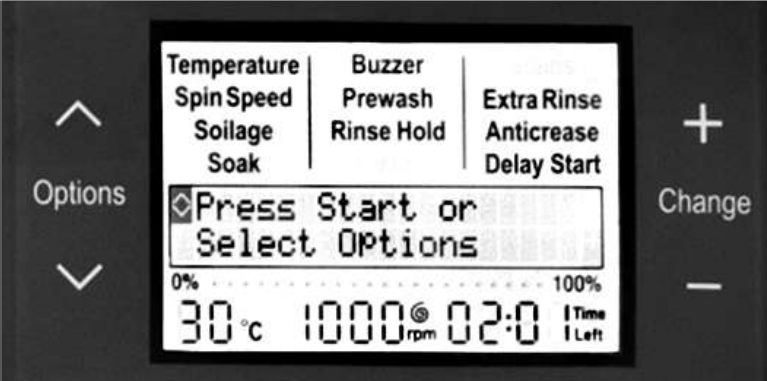
- Program selection.
- Additional wash option selection.
- Balance time of the program.
- Program status.
- Problem/fault indications, if any.
- Child Lock selection.
- Door Status.
Important If Program Selector is rotated during program run, "(Selected Program name)" "Adjust Knob pos." will be shown on the display.
For any code which is not present in the following list or if the suggested solution doesn't fix the problem, call lFB Care or dealer.
| DISPLAY MESSAGE | PROBABLE CAUSES | SOLUTION |
|---|---|---|
| "Program End-Disable Child Lock" | Child Lock is selected. | Disable the Child Lock by pressing Change + and - buttons. |
| "Child Lock ON-Disable Child Lock" | Child Lock is selected. | Disable the Child Lock by pressing Change + and - buttons. |
| "Program Paused-Door Open Not Possible" | For safety reasons, the washing machine door cannot be opened when water level, temperature or speed is too high. | Select Spin Speed or press Start button or select drain program. |
| "Delay Start-Program Name" | Delay Start option is selected. | Program will resume automatically after delay period is over. |
| "Door Open-Pls Close Door" | Door not closed properly. Door not locked. | Open and then close the door firmly. |
| "Door Locked Error" | Door not getting unlocked. | Switch the Program Selector to OFF position, wait for 2 minutes and check if the door can open. Do not try to open the door forcefully. If the same message is displayed, switch OFF the appliance and contact IFB Care. |
| "No Water?-Check Water Tap" | Water tap turned OFF. Water supply not available or low water pressure. | Turn on the tap. Washing machine will start automatically on resumption of water supply. |
| "Low Water Pressure?" | Sieve/filter blocked in water inlet hose. Bent/damaged water inlet hose. | Clean sieve/filter. Remove bend/damage. |
| "Water Over Flow-Turn OFF tap" | Water Over Flow. | Switch the Program Selector to OFF position, wait for 2 secs and switch OFF the appliance. Contact IFB Care. |
| "Motor Error-Switch OFF machine" | Cloth trapped between drum and door area. | Switch the Program Selector to OFF position, wait for 2 secs and run Drain program. After End, rearrange the clothes and restart the required program. If the same message appears again, switch OFF the appliance and contact IFB Care. |
| "Over Heating error-Switch OFF the machine" | Water temperature is above 60°C at the start of the program. | Start new/Drain program once water cools down to approximately 60°C. Switch the Program Selector to OFF position, wait for 2 secs and restart. If the same message appears again, switch OFF the appliance. Contact IFB Care. |
| "Drain Error" | Water not drained. | Press Start/Pause button to restart the drain. Filter blocked. Drain hose clogged/bent. |
| "Low Voltage Error-Wait/Switch OFF" | If Input voltage is low, machine will start automatically after the voltage increases to safe operating level. If this error display persists/occurs frequently, then contact your electrician to locate the fault in the electrical system. | |
| "High Voltage Error-Wait/Switch OFF" | If input voltage is high, machine will start automatically after the voltage reduces to safe operating level. If this error display persists/occurs frequently, then contact your electrician to locate the fault in the electrical system. | |
| "High Unbalanced Load-Refer User Manual" | Laundry load is unbalanced. | If laundry load is small (e.g. a pair of jeans, 2-3 Turkish towels, bathrobe etc.) it can lead to an unbalanced condition. Add 1-2 similar items to help balance the load and rearrange load to allow proper spinning. |
IFB Appliances Senator Aqua SX 8KG Machine 1400RPM Pros & Cons
Pros
- High spin speed for faster drying
- Multiple wash cycles for various fabric types
- 5-Star energy efficiency rating for reduced power consumption
- Stainless steel drum for durability and rust resistance
- Electronic controls with LED display for easy operation
Cons
- Higher noise levels during operation compared to some models
- Requires regular maintenance to ensure optimal performance
- May be slightly heavier due to its robust build
Customer Reviews
Customers have generally praised the IFB Appliances Senator Aqua SX 8KG 1400RPM for its reliable performance, advanced features, and energy efficiency. However, some users have noted that it can be quite loud during operation and requires regular cleaning to maintain its performance.
Common Complaints
- Noise levels during operation
- Need for regular maintenance
Warranty
IFB Appliances Senator Aqua SX 8KG Machine 1400RPM Industries Ltd (the Company) warrants to the original domestic purchaser of this washing machine (Appliance) that it is free from defects in workmanship and materials. During 48 months from the date of purchase of the new washing machine all the parts of the washing machine which prove to be defective in workmanship and/or materials shall be replaced or repaired free of charge on intimation to the Company/Company's authorised service centre nearest to the place where the appliance is installed. This warranty is subject to limitations of warranty.
Faqs
What is the capacity of the IFB washing machine?
How many wash cycles does this washing machine offer?
What material is the drum made of in the IFB Appliances?
What is the spin speed of this washing machine?
Is the IFB Appliances Senator energy efficient?
How do I troubleshoot issues with my washing machine?
What are some pros of the Aqua SX 8KG 1400RPM?
What are some cons of the IFB?
How do I set up my new IFB Appliances Senator Aqua SX 8KG Machine 1400RPM washing machine?
What should I do if my washing machine is unbalanced?
Leave a Comment
